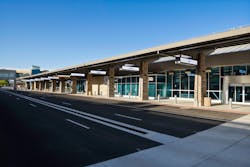Transforming the Gateway: The Reno-Tahoe International Airport Ticketing Hall Expansion

The Reno-Tahoe International Airport has undergone a remarkable transformation thanks to the ambitious More Reno program initiated by the Reno-Tahoe Airport Authority (RTAA). This multi-phase initiative aimed to enhance the passenger experience, improve operations, and modernize the airport's infrastructure. A significant part of this effort was the expansion of the ticketing hall, a project led by RS&H as the architectural firm in collaboration with McCarthy, the Construction Manager at Risk (CMAR).
"The Reno-Tahoe Airport Authority launched the More Reno program, which was a multi-phase initiative to expand the Reno-Tahoe International Airport in various capacities," explains Geoffrey Chevlin, Project Architect and Architect of Record for the ticketing hall expansion. "The main goals were to alleviate congestion, improve passenger flow, and modernize the space while maintaining a 'Modern Mountain' aesthetic."
Amanda Twitchell, Reno-Tahoe Airport Authority Senior Project Manager the airport needed to increase airline queuing and check-in space, improve wayfinding, add restrooms, increase natural light, and access to views. Leaders also wanted it to embody the Reno-Tahoe region through the modern mountain aesthetic.
"There was a significant amount of unused space along our outside drop-off curb area, Nicolle Staten, Reno-Tahoe Airport Authority Manager of Public Affairs said. “With the Ticketing Hall Expansion, we were able to utilize that space to accomplish our goals in bringing more space, more light, and more amenities to the heavily used Ticketing Hall.
Design Approach
Chevlin said the design process was an intricate balance between modern and mountain themes. RS&H held several visioning workshops with the Reno-Tahoe Airport Authority team to understand what modern mountain meant to the leadership team.
"Modern mountain was more of a concept than technological advancement. Think of a combination of an Apple store and a timber Mountain Lodge," Chevlin says. "We wanted to represent the region, combining the high desert in Reno and the Lake Tahoe mountain area, and still make this a modern facility for the 21st century."
The design team facilitated in-depth conversations with RTAA to define the airport's DNA, aligning it with the region's natural context. The design embodies the natural context of crystal blue water, open skies, carved stone, and tree-lined forests. Large expanses of blue glazing, dynamic angular forms of glass, metal siding, and concrete provided an elegant contrast, while stone forms anchored the ticketing hall.
"We used stone, concrete, glass, and even exposed steel to represent both the modern and the natural elements," Chevlin said.
One of the most significant challenges was managing the project during the COVID-19 pandemic. Supply chain issues were a major hurdle as this project began right in the middle of COVID in 2021. The collaborative nature of the CMAR delivery method was crucial in overcoming these challenges.
"This project was probably the best-integrated project delivery I have been a part of, working closely with the contractor and the owner from the onset of concept through design and into construction," Chevlin said.
Budget management was another critical challenge. The team held frequent checkpoint meetings to ensure design goals were met while staying within budget.
"We’re forecasting to finish the project close to $1 million under budget, said Twitchell. “The entire project team worked closely to identify potential cost savings and adjust the design and construction work to accomplish them without compromising any critical safety measures or necessities,"
In addition to being under budget, the project was completed on time with zero lost time injuries.
“This speaks to the incredible leadership and partnership between our Senior Project Manager Amanda Twitchell and McCarthy Construction Superintendent Cody Harris," said Staten.
Built for the Future
Sustainability, although not a formal requirement for LEED certification, was a priority for the airport. Daylight harvesting was a significant focus, with light fixtures dynamically responding to the amount of natural light entering the space. The use of LEDs exceeded baseline code requirements, and local materials were prioritized to minimize environmental impact.
"Even if we had to demo concrete, we looked at ways to break it down and reuse it as base material," Chevlin said.
The new Ticketing Hall has enhanced and efficient airflow circulation by upgrading the outdated and inefficient mechanical system, which removed four units and replaced them with one large unit. The team also used 1,500 square feet of reclaimed wood sourced from the West Coast, installed daylight sensors that dim or brighten the artificial lighting based on the amount of natural light that is entering the new 14-foot tall curtain wall, and added access to views and natural daylight which enhances both tenant and passenger well-being and satisfaction.
Engaging various stakeholders was a cornerstone of the project's success. Chevlin said RS&H initiated an inclusive design process to align multiple ideas and visions into a cohesive concept. Frequent collaboration with RTAA, airlines, and local community members ensured the project met both operational and community needs.
"It was about making sure we were always talking to the stakeholders, not just at milestones but continuously through the entire design process," he said.
The design team held workshops and one-on-one meetings with all the stakeholders regularly throughout the design process.
“The team then continued to engage stakeholders at key milestones throughout construction to confirm direction," Twitchell said.
The new ticketing hall integrates advanced travel technologies to enhance the passenger experience. Reno implemented dynamic signage by Daktronics, which is programmable and can display airline information along the 450-foot-long curb. The infrastructure also includes future-proofing elements such as walker duct systems to accommodate additional kiosks as needed. This ensures the ticketing hall can adapt to future technological advancements and passenger needs.
"The addition of more self-service kiosks is an enhancement that really catches us up to the 21st century,” Staten said. “This was technology that was much needed and something that our previous infrastructure could not support to this scale. We also installed digital signs along the roadway so passengers can easily find their airline, and it’s more efficient and cost-effective for us to change.”
Public art plays a significant role in the Reno-Tahoe region, and the new ticketing hall reflects this cultural importance. Art is very important in the Reno-Tahoe area, from the Riverwalk to various city locations. The airport needed to represent this as well. The public art in the ticketing hall celebrates the flora and fauna of the region, enhancing the overall passenger experience.
"The Reno-Tahoe Airport Authority Board of Trustees have pledged a minimum 1 percent of design and construction costs for capital improvement projects in public spaces from RTAA funds for art,” Staten said. “This brought us our first-ever public art commission ‘Repeated Refrains’ by Dixie Friend Gay.”
Gay spent time researching the Reno area and environment to pick out elements that make the region unique.
“You’ll notice with the modern mountain aesthetic design, was really important for us to stay true to, Staten said. “As you walk along the 450 feet of art, it changes with the seasons because Reno-Tahoe is very lucky to experience all four seasons. I will also note that the installation was very challenging in itself, having to be done mostly at night and in-between flight schedules to not disturb our airport operations.”
Key Lessons Learned
Reflecting on the project, Chevlin emphasizes the importance of teamwork and continuous collaboration. Ensuring constant pricing exercises, not just milestone to milestone but week to week, was crucial to staying on budget. The project's success was also attributed to the cohesive partnership between the architect, contractor, and owner.
"The owner builds the culture, and with the right team, the project follows suit,” Chevlin said. “It's about having the right partners on board to ensure the journey is as successful as the end result."
Staten said nearly 100,000 hours of total work were tracked by various contractors and sub-contractors where most of the work had to be done at night to minimize disruption to airline partners and passengers. Some remodeling work occurred outside the temporary walls which required extreme attention to detail and logistical planning where each night the teams prepped the area for passenger traffic in the morning.
“The team managed to keep the entire Ticketing Hall ADA-compliant and fully operational during the project,” Staten said. “That’s pretty remarkable and a true testament to the strong partnerships throughout the project.”
About the Author
Joe Petrie
Editor & Chief
Joe Petrie is the Editorial Director for the Endeavor Aviation Group.
Joe has spent the past 20 years writing about the most cutting-edge topics related to transportation and policy in a variety of sectors with an emphasis on transportation issues for the past 15 years.
Contact: Joe Petrie
Editor & Chief | Airport Business
+1-920-568-8399
>> To download the AviationPros media kits, visit: Marketing Resource Center
>>Check out our aviation magazines: Ground Support Worldwide | Airport Business | Aircraft Maintenance Technology
